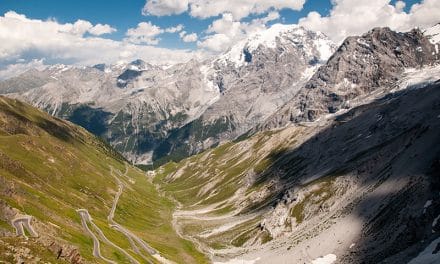As you may have guessed, there’s a lot more to taking a great landscape photo than just finding a breathtaking view. There are a number of factors that go into creating a balanced photo that is not just beautiful, but interesting, too.
1. Expand The Depth Of Field
Depth of field is a major component to a landscape photo. In most cases, you’ll want the depth of field to stretch back as far as the eye (and camera) can see. In doing so, you are making sure all parts of the photo are in focus, even the far off background.
Let’s use the photo below as an example. Do you see how the photographer has made a point to make sure the foreground, mid-ground, and background are in focus? Sure, you loose a little detail in the mountain range due to sheer distance from camera to mountain, but for the most part they are still pretty sharp! Now, imagine if those mountains had fallen off into a soft, fuzzy bokeh we commonly see in portrait photography. Without those mountains, this image would loose a lot of it’s interest!
→ Related Reading: 11 Steps to Tack-Sharp Landscape Photos
2. Point Of Interest
While there’s a lot to be said for the singular beauty of a scenic view alone, you can make your landscapes even more appealing by giving the eye something to rest on within the composition. This way, viewers do not become lost in a photo looking for the subject, making it easier on the eyes to look at.
Most typically, this will also be your focal point–or the element in the photo of which you want to be the center of focus. This can be a human element, a building, a tree, the milky way, or any number of other things.
3. Leading Lines
Leading lines are another “rule of photography” that can almost instantly take a photo to the next level. Part of what makes a leading line so magical is that you can use it direct the viewer’s to different parts of the photograph.
4. Horizon
When evaluating the horizon, you should first and foremost make sure that it is straight! Nothing can deteriorate a good landscape composition quicker than a uneven horizon. This is one of the reasons some tripod have a bubble levels and some DSLRs have virtual horizon indicators–it’s that important!
You’ll also want to make sure you compose your landscape so the horizon line falls in an aesthetically appealing area. Beginners may be tempted to stick the horizon right across the center of the photo, but this isn’t necessarily what will work best. Try sticking to the rule of thirds and compose your image so the horizon falls on the bottom or top third of the frame. Of course, rules are meant to be broken, so don’t be afraid to break away from it, but know that it’s always there as a fall back just in case!
Photo license links: CC BY-SA 2.0, CC BY-ND 2.0












